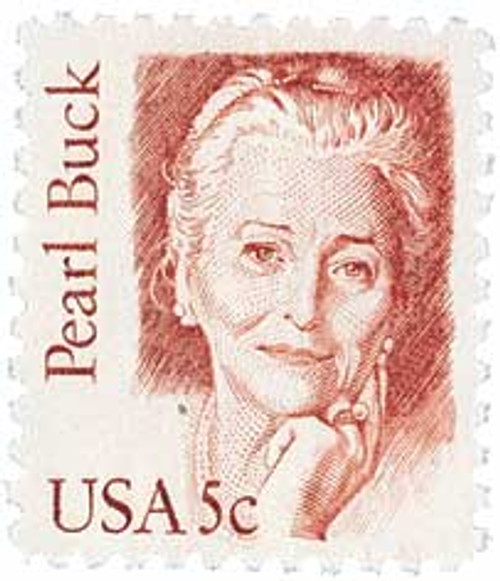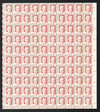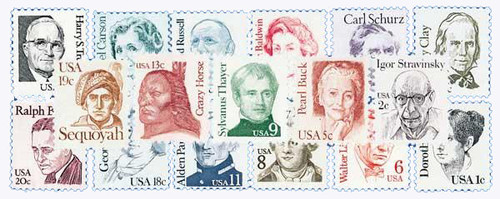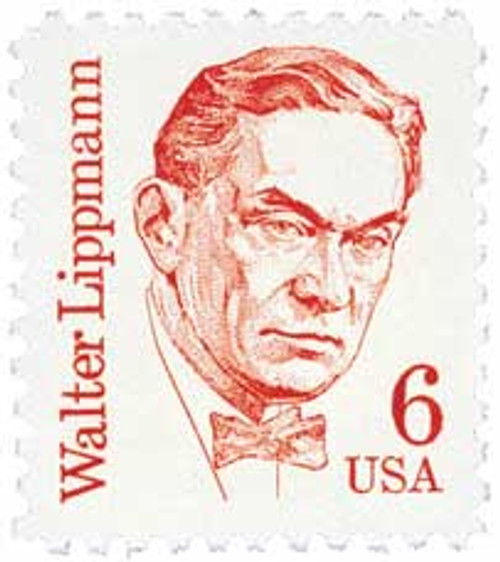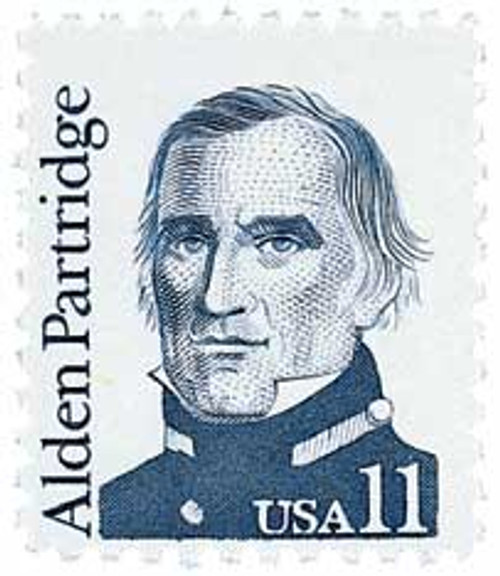
# 1848 - 1983 5c Great Americans: Pearl Buck
U.S. #1848
1983 5¢ Pearl Buck
Great Americans
- 11th Stamp in Great Americans Series
- Honors the first American female Nobel laureate in literature
- Issued one day before Buck’s 91st birthday
Stamp Category: Definitive
Series: Great Americans
Value: 5¢; used predominantly as a “change maker”
First Day of Issue: June 25, 1983
First Day City: Hillsboro, West Virginia
Quantity Issued: 150,000,000
Printed by: Bureau of Engraving & Printing
Printing Method: Engraved
Format: Panes of 100
Perforations: 11 x 10.5
Color: Henna brown
Why the stamp was issued: This stamp raised some concern when it was announced because it was intended to replace the 1967 5¢ George Washington, and many were upset at the idea of there not being a valid stamp depicting our first president.
The most common use for this stamp was as a “change maker.” As Don McDowell of the Stamps Division pointed out, “When a small post office without a meter machine quotes a parcel post rate of $1.86 to a customer, they’d better have the ‘change maker’ stamps on hand to hit it exactly.” These low denominations were also useful in the event of a rate change.
About the stamp design: Designed by renowned stamp artist Paul Calle, the portrait on this stamp was based on a painting by Freeman Elliot from the Pearl Buck Foundation.
First Day City: The First Day ceremony for this stamp was held at the Hillsboro Elementary-Middle School Auditorium in Buck’s hometown of Hillsboro, West Virginia.
About the Great Americans Series: The Great Americans Series was created to replace the Americana Series. The new series would be characterized by a standard definitive size, simple design, and monochromatic colors.
This simple design included a portrait, “USA,” the denomination, the person’s name, and in some cases, their occupation or reason for recognition. The first stamp in the new series was issued on December 27, 1980. It honored Sequoyah and fulfilled the new international postcard rate that would go into effect in January 1981.
The Great Americans Series would honor a wider range of people than the previous Prominent Americans and Liberty Series. While those series mainly honored presidents and politicians, the Great Americans Series featured people from many fields and ethnicities. They were individuals who were leaders in education, the military, literature, the arts, and human and civil rights. Plus, while the previous series only honored a few women, the Great Americans featured 15 women. This was also the first definitive series to honor Native Americans, with five stamps.
The Bureau of Engraving and Printing (BEP) produced most of the stamps, but private firms printed some. Several stamps saw multiple printings. The result was many different varieties, with tagging being the key to understanding them. Though there were also differences in perforations, gum, paper, and ink color.
The final stamp in the series was issued on July 17, 1999, honoring Justin S. Morrill. Spanning 20 years, the Great Americans was the longest-running US definitive series. It was also the largest series of face-different stamps, with a total of 63.
Click here for all the individual stamps and click here for the complete series.
History the stamp represents: Author Pearl Sydenstricker Buck was born on June 26, 1892, in Hillsboro, West Virginia. She was awarded the Pulitzer Prize in 1932, the Nobel Prize in 1938, and was the only woman at that time to receive both honors.
Buck’s parents had lived in China prior to her birth, but returned to the US so she could be born there. When she was five months old, they went back to China. Buck grew up in Huai-an, Zhenjuang, and Shanghai. She learned English, classical Chinese, and the local Chinese dialect. Buck loved to read and would later read all of Charles Dickens’s novels every year.
Buck returned to the US in 1911 to attend Randolph-Macon Woman’s College in Virginia. While she didn’t initially intend to return to China, when she received word that her mother was ill, she applied to become a Presbyterian missionary, serving from 1914 to 1932.
Pearl married John Lossing Buck in 1917 and taught English literature at a few Chinese colleges and universities. She and her husband returned to the US in 1924 for a year, during which time she earned her master’s degree from Cornell University. After returning to China, her family was displaced during the Nanking Incident of March, 1927. They spent a day in hiding before fleeing to Japan for most of the remainder of the year.
Once she returned to China in late 1927, Buck decided to become a professional writer to support herself and care for her sick daughter. Three years later, she published her first novel, East Wind: West Wind. She followed that a year later with The Good Earth. The Good Earth was the best-selling fiction novel in the US in 1931 and earned Buck the Pulitzer Prize in 1932.
On a later trip back to the US, Buck gave a speech at a Presbyterian women’s luncheon that shared her belief that missionaries to China were unnecessary. When her address was published in Harper’s Magazine, she came under heated criticism and resigned her position with the Presbyterian Board.
Buck moved back to the US permanently in 1934, and was prohibited from returning to China following the Communist Revolution. In 1938 she became the first American woman to win the Nobel Prize in Literature, “for her rich and truly epic descriptions of peasant life in China and for her biographical masterpieces.”
Buck continued to write novels and short stories for the rest of her life. Many of her works explored women’s rights, Asian culture, immigration, adoption, missionary work, war, and violence. She aided a relief campaign for victims of the 1931 China floods. In 1949, Buck helped co-found Welcome House Inc. which was the first international, interracial adoption agency. Then in 1964, she founded the Pearl S. Buck Foundation to provide aid to children who weren’t eligible for adoption. Buck also opened orphanages in South Korea, Thailand, the Philippines, and Vietnam.
Buck died of lung cancer on March 6, 1973. Buck’s birthplace was later made into a historic house and cultural center on the National Register of Historic Places. Her former home at Nanjing University was designated a memorial house.
U.S. #1848
1983 5¢ Pearl Buck
Great Americans
- 11th Stamp in Great Americans Series
- Honors the first American female Nobel laureate in literature
- Issued one day before Buck’s 91st birthday
Stamp Category: Definitive
Series: Great Americans
Value: 5¢; used predominantly as a “change maker”
First Day of Issue: June 25, 1983
First Day City: Hillsboro, West Virginia
Quantity Issued: 150,000,000
Printed by: Bureau of Engraving & Printing
Printing Method: Engraved
Format: Panes of 100
Perforations: 11 x 10.5
Color: Henna brown
Why the stamp was issued: This stamp raised some concern when it was announced because it was intended to replace the 1967 5¢ George Washington, and many were upset at the idea of there not being a valid stamp depicting our first president.
The most common use for this stamp was as a “change maker.” As Don McDowell of the Stamps Division pointed out, “When a small post office without a meter machine quotes a parcel post rate of $1.86 to a customer, they’d better have the ‘change maker’ stamps on hand to hit it exactly.” These low denominations were also useful in the event of a rate change.
About the stamp design: Designed by renowned stamp artist Paul Calle, the portrait on this stamp was based on a painting by Freeman Elliot from the Pearl Buck Foundation.
First Day City: The First Day ceremony for this stamp was held at the Hillsboro Elementary-Middle School Auditorium in Buck’s hometown of Hillsboro, West Virginia.
About the Great Americans Series: The Great Americans Series was created to replace the Americana Series. The new series would be characterized by a standard definitive size, simple design, and monochromatic colors.
This simple design included a portrait, “USA,” the denomination, the person’s name, and in some cases, their occupation or reason for recognition. The first stamp in the new series was issued on December 27, 1980. It honored Sequoyah and fulfilled the new international postcard rate that would go into effect in January 1981.
The Great Americans Series would honor a wider range of people than the previous Prominent Americans and Liberty Series. While those series mainly honored presidents and politicians, the Great Americans Series featured people from many fields and ethnicities. They were individuals who were leaders in education, the military, literature, the arts, and human and civil rights. Plus, while the previous series only honored a few women, the Great Americans featured 15 women. This was also the first definitive series to honor Native Americans, with five stamps.
The Bureau of Engraving and Printing (BEP) produced most of the stamps, but private firms printed some. Several stamps saw multiple printings. The result was many different varieties, with tagging being the key to understanding them. Though there were also differences in perforations, gum, paper, and ink color.
The final stamp in the series was issued on July 17, 1999, honoring Justin S. Morrill. Spanning 20 years, the Great Americans was the longest-running US definitive series. It was also the largest series of face-different stamps, with a total of 63.
Click here for all the individual stamps and click here for the complete series.
History the stamp represents: Author Pearl Sydenstricker Buck was born on June 26, 1892, in Hillsboro, West Virginia. She was awarded the Pulitzer Prize in 1932, the Nobel Prize in 1938, and was the only woman at that time to receive both honors.
Buck’s parents had lived in China prior to her birth, but returned to the US so she could be born there. When she was five months old, they went back to China. Buck grew up in Huai-an, Zhenjuang, and Shanghai. She learned English, classical Chinese, and the local Chinese dialect. Buck loved to read and would later read all of Charles Dickens’s novels every year.
Buck returned to the US in 1911 to attend Randolph-Macon Woman’s College in Virginia. While she didn’t initially intend to return to China, when she received word that her mother was ill, she applied to become a Presbyterian missionary, serving from 1914 to 1932.
Pearl married John Lossing Buck in 1917 and taught English literature at a few Chinese colleges and universities. She and her husband returned to the US in 1924 for a year, during which time she earned her master’s degree from Cornell University. After returning to China, her family was displaced during the Nanking Incident of March, 1927. They spent a day in hiding before fleeing to Japan for most of the remainder of the year.
Once she returned to China in late 1927, Buck decided to become a professional writer to support herself and care for her sick daughter. Three years later, she published her first novel, East Wind: West Wind. She followed that a year later with The Good Earth. The Good Earth was the best-selling fiction novel in the US in 1931 and earned Buck the Pulitzer Prize in 1932.
On a later trip back to the US, Buck gave a speech at a Presbyterian women’s luncheon that shared her belief that missionaries to China were unnecessary. When her address was published in Harper’s Magazine, she came under heated criticism and resigned her position with the Presbyterian Board.
Buck moved back to the US permanently in 1934, and was prohibited from returning to China following the Communist Revolution. In 1938 she became the first American woman to win the Nobel Prize in Literature, “for her rich and truly epic descriptions of peasant life in China and for her biographical masterpieces.”
Buck continued to write novels and short stories for the rest of her life. Many of her works explored women’s rights, Asian culture, immigration, adoption, missionary work, war, and violence. She aided a relief campaign for victims of the 1931 China floods. In 1949, Buck helped co-found Welcome House Inc. which was the first international, interracial adoption agency. Then in 1964, she founded the Pearl S. Buck Foundation to provide aid to children who weren’t eligible for adoption. Buck also opened orphanages in South Korea, Thailand, the Philippines, and Vietnam.
Buck died of lung cancer on March 6, 1973. Buck’s birthplace was later made into a historic house and cultural center on the National Register of Historic Places. Her former home at Nanjing University was designated a memorial house.

